Top of page
The personal mission patch for CSA astronaut Jeremy Hansen, based on artwork by artist Henry Guimond of Sagkeeng First Nation in Manitoba. (Credit: CSA)
Patches are an integral part of space culture. When a crew is assigned to a mission, NASA creates a patch for them. Usually, when an astronaut belongs to a space agency other than NASA, that agency also creates a personal patch for its crewmember. The patch reflects the mission objectives and some personal preferences of the astronaut who wears it proudly both on Earth and in space. Mission patches have been worn by NASA astronauts since and by Canadian Space Agency (CSA) astronauts since , when the first Canadian flew in space.
For CSA astronaut Jeremy Hansen’s participation in the historic Artemis II mission to the Moon, his mission patch was graciously created by Anishinaabe artist Henry Guimond. It was done with the contribution of Dave Courchene III (Sabe), Leader of the Turtle Lodge in Sagkeeng First Nation (Manitoba).
For the past decade, Jeremy has been fortunate to be invited by numerous Indigenous communities to sit with Elders and Knowledge Keepers. They have blessed him with knowledge and teachings that he carries with him as he prepares for his mission. These precious experiences have given Jeremy a profound appreciation for Indigenous ways of knowing.
While the patch contains elements of Anishinaabe culture that do not reflect all First Nations, Inuit and Métis cultures, working with an Indigenous artist to create the patch he will wear with great humility as he represents our country in space was Jeremy’s way to recognize the importance of traditional knowledge and Indigenous Peoples of Canada.
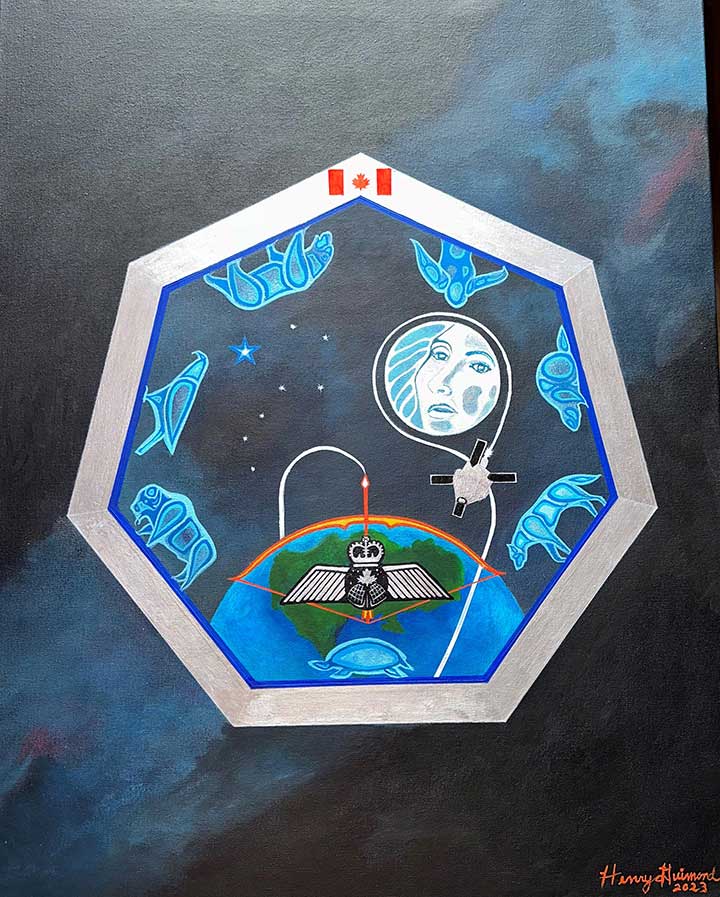
Original painting of Jeremy Hansen’s mission patch by Henry Guimond. (Credit: CSA)
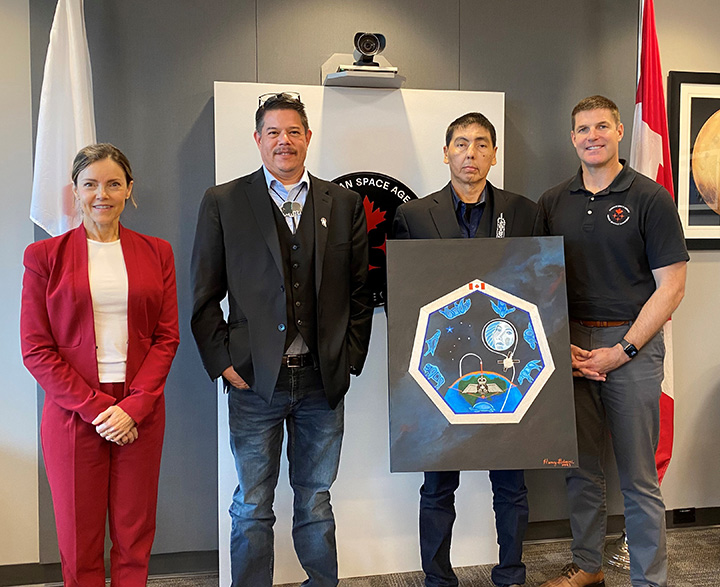
CSA President Lisa Campbell; Dave Courchene III, Leader of the Turtle Lodge; Henry Guimond, artist; CSA astronaut Jeremy Hansen. (Credit: CSA)
About the patch
This patch was created for CSA astronaut Colonel Jeremy Hansen in honour of his participation in the historic Artemis II mission to the Moon by Anishinaabe artist Henry Guimond of the Turtle Lodge.
The heptagonal shape and the animals are a reference to the Seven Sacred Laws, a traditional First Nations teaching shared with Jeremy in preparation for his journey around Grandmother Moon. This teaching is but one example of many rich and selfless teachings found in the diverse cultures of Indigenous Peoples, the first explorers.
The bow represents Artemis, the twin sister of Apollo, the Greek goddess of the hunt, nature, and the Moon. Artemis launches her arrow with the astronauts, sending them around Grandmother Moon who conveys the cycle of life. It is said that she watches over the waters of Earth, regulates the tides and feeds life. The arrow launches from Turtle Island, which refers to the continent of North America in the creation stories of some Indigenous peoples.
The Royal Canadian Air Force astronaut wings are symbolic of the Canadian Armed Forces’ role in Canada’s journey to the Moon and recognize the sacrifice of Jeremy’s fellow service members and their families. The Canadian flag at the top pays tribute to the thousands of people who have worked across our country to make this mission possible, but also to symbolically bring all Canadians along on this mission around the Moon.
The Big Dipper and the North Star, easily recognizable in the night sky of the northern hemisphere, are a reminder that humanity exists amongst an unimaginably expansive universe, as the stars visible to the human eye in our night sky are limited to only those of the Milky Way, our galaxy. Starting with Indigenous peoples, explorers have used these visible stars for navigation, and astronauts continue to navigate by them in deep space. The North Star is shown as a five-pointed star to represent the five members of the Hansen family as well as Texas, where Jeremy and his family have been living since he was recruited as a CSA astronaut.
The silver border represents the Orion capsule that will support the crew on their journey. The CSA is fittingly represented within this border as well to honour the extraordinary efforts of both its past and present members to support space exploration and bring its benefits back to humanity.
Inside the silver border is a thin blue line. The blue represents the light or spirit that is in all of us – in all humankind, plants and animals. This spirit will travel with the crew aboard the capsule.
Jeremy Hansen’s mission patch: recognizing Indigenous Peoples
The Seven Sacred Laws
The heptagonal shape of the patch is a reference to the Seven Sacred Laws, or Seven Grandfather Teachings. The Seven Sacred Laws are ancestral values that inspire our conduct as human beings, and bring us back to a relationship with Mother Earth. They are represented by seven animals. Each animal offers a special gift and understanding of how we as people can live in harmony with one another.
What each animal symbolizes, as shared with us by Sabe, Leader of Turtle Lodge (edited for concision):
- Buffalo – Respect
-

The buffalo represents respect. It gives its entire being to feed the people, for them to live. Elders teach that when you respect others, you give of yourself, you give your life to help people around you to create a better existence for all. - Eagle – Love
-

The eagle represents love. Grandmothers say that one of the most powerful medicines we have is love, that love is a powerful healer. The eagle also symbolizes vision and sight. It is important to see ahead, to have a vision of one’s purpose and to work towards it. Elders teach that one’s true purpose is always rooted in love and in support of others. - Bear – Courage
-
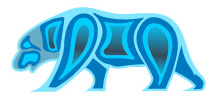
A very physically powerful animal, the bear represents courage. A mother bear is fearless in the protection of her cubs. It is natural for her to display courage and strength, to do what is right in life. It is not always easy to face challenges, follow one’s purpose and do the right thing. Only with the courage and resilience of the bear will you be able to face and overcome the challenges that could prevent you from living out your life’s purpose. - Bigfoot – Honesty
-
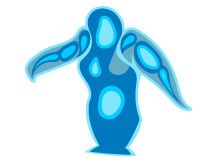
Sasquatch or Bigfoot – Sabe or “giant” in the Ojibway language – represents the importance of honesty and being true to one’s word. Say what you mean and be honest with yourself and others. Elders often exemplify this trait; when they say something, their word is a commitment and can be counted upon. Honesty is also speaking true and good words about others and avoiding gossip. - Beaver – Wisdom
-

The beaver represents wisdom. It has an incredible gift to build and create, as well as the wisdom of how to use this gift. The beaver’s creation harnesses life-giving water to create important ecosystems that support and enable life. It can even channel water back into an area following a devastating forest fire, renewing and revitalizing that ecosystem.
Like the beaver, we all have a special gift to offer others. Use the wisdom of the beaver to acknowledge your gifts and put them to use in the service of others: this is the source of life satisfaction and happiness.
- Wolf – Humility
-
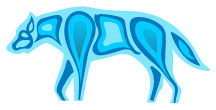
The wolf represents humility, acknowledging that there is a higher power and natural laws governing the universe. Showing gratitude for our life and our existence, while acknowledging that we are all equal is a sign of humility. The sun shines on us all equally, and no one is better or less than others. - Turtle – Truth
-

The turtle is truth. The Elders say that in order to know and understand truth, we have to learn to understand the six other teachings: respect, love, courage, honesty, wisdom, humility. The turtle leaves a trail, truth, for us to follow. As we are constantly faced with challenges, we should do our best to follow that trail and live truthfully.
In the original artwork, we can also see Henry’s interpretation of the universe in the background: the way it looks, the way it moves.
Kinanakominigo (our deep thanks from the heart) to Henry and Sabe for working with Jeremy and our team, and graciously sharing their knowledge and teachings.
About Henry Guimond
Henry Guimond is an artist born and raised on the Sagkeeng First Nation, Manitoba. His artwork is featured in the Canadian Museum for Human Rights and in many homes and businesses in the community. Henry has a special talent for painting traditional names. Henry Guimond is also an architect and builder. He was the architect and head man in the construction of the Turtle Lodge in Sagkeeng First Nation, and is also responsible for the construction of many other beautiful lodges and structures. (source: TurtleLodge.org)
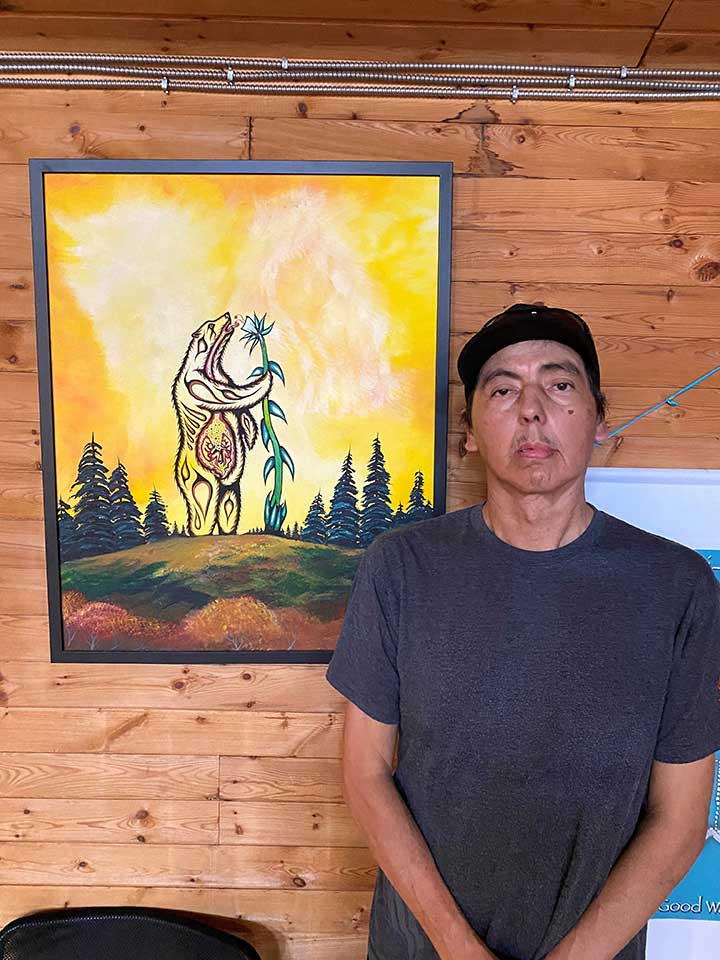
Henry Guimond in front of one of his pieces of artwork at the Turtle Lodge. (Credit: Turtle Lodge)
Explore further
- Date modified: